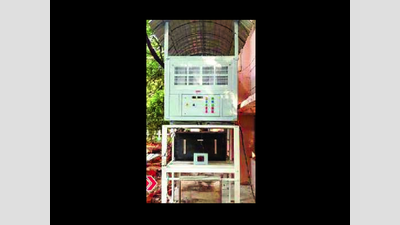- News
- City News
- Hyderabad News
- ‘Meghdoot’ auto generator to draw water from thin air
Trending
This story is from June 23, 2018
‘Meghdoot’ auto generator to draw water from thin air
The city-based Indian Institute of Chemical Technology (IICT) is working on a low-cost atmospheric water generator (AWG) that will draw water literally from the thin air. The premier chemical technology research body on Friday signed a memorandum of understanding (MoU) with Maithri Aquatech for commercial production of AWG dubbed Meghdoot that would help people living in perennial drought-hit and water scarcity areas.

The machine will trap the air, clean it of all pollutants and draw moisture
HYDERABAD: The city-based Indian Institute of Chemical Technology (IICT) is working on a low-cost atmospheric water generator (AWG) that will draw water literally from the thin air. The premier chemical technology research body on Friday signed a memorandum of understanding (MoU) with Maithri Aquatech for commercial production of AWG dubbed Meghdoot that would help people living in perennial drought-hit and water scarcity areas.
All one has to do is to install the AWG and switch it on.The machine will trap the air, clean it of all pollutants and draw moisture. The higher the temperature and humidity, the larger the quantity of water produced from the air. The prototype of the indigenous AWG is now kept on display at the IICT Tarnaka campus. The production is likely to begin in August at the Moula Ali campus of the IICT.

Though imported AWGs are now available in India, they are expensive both in cost and operation. The indigenous AWG developed by IICT scientists is not only cost-effective but also produces pure drinking water at an affordable price. It is estimated at a litre of pure potable water would cost about Rs 2. The price would go down once the technology catches up in the Indian market.
The Membrane Group of the IICT led by Dr S Sridhar, principal scientist, has been actively involved in tackling fluorosis and other water-borne diseases through development of novel membrane filters suitable for treating different types of raw water sources, for the past 14 years, for rural and urban population of five million.
The IICT scientist said only about one per cent of all the water on earth is potable. In India, most of the drinking water comes from the underground aquifers, which are subject to contamination by nitrates, fluoride, arsenic, microorganisms and industrial contaminants such as lead and mercury. A permanent solution for the freshwater crisis of human population is to be found not in the hydrosphere or the lithosphere, but in the atmosphere.
All one has to do is to install the AWG and switch it on.The machine will trap the air, clean it of all pollutants and draw moisture. The higher the temperature and humidity, the larger the quantity of water produced from the air. The prototype of the indigenous AWG is now kept on display at the IICT Tarnaka campus. The production is likely to begin in August at the Moula Ali campus of the IICT.

Though imported AWGs are now available in India, they are expensive both in cost and operation. The indigenous AWG developed by IICT scientists is not only cost-effective but also produces pure drinking water at an affordable price. It is estimated at a litre of pure potable water would cost about Rs 2. The price would go down once the technology catches up in the Indian market.
IICT director S Chandrasekhar and Maithri Aquatech managing director K Ramakrishna explained the importance and fun ctioning of AWG in far flung rural areas where fetching a pail of potable water is a daily physical strain particularly for the womenfolk. Scientist and author Arun Tiwari, an associate of Dr APJ Abdul Kalam, described AWG as a boon to people living in water scarcity areas.
The Membrane Group of the IICT led by Dr S Sridhar, principal scientist, has been actively involved in tackling fluorosis and other water-borne diseases through development of novel membrane filters suitable for treating different types of raw water sources, for the past 14 years, for rural and urban population of five million.
The IICT scientist said only about one per cent of all the water on earth is potable. In India, most of the drinking water comes from the underground aquifers, which are subject to contamination by nitrates, fluoride, arsenic, microorganisms and industrial contaminants such as lead and mercury. A permanent solution for the freshwater crisis of human population is to be found not in the hydrosphere or the lithosphere, but in the atmosphere.
End of Article
FOLLOW US ON SOCIAL MEDIA










